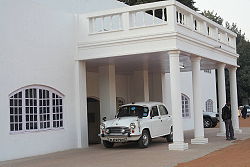
Indira Kalakendra
Encyclopedia

New Delhi
New Delhi is the capital city of India. It serves as the centre of the Government of India and the Government of the National Capital Territory of Delhi. New Delhi is situated within the metropolis of Delhi. It is one of the nine districts of Delhi Union Territory. The total area of the city is...
(IGNCA) ( Devanagari
Devanagari
Devanagari |deva]]" and "nāgarī" ), also called Nagari , is an abugida alphabet of India and Nepal...
: इन्दिरा गांधी राष्ट्रीय कला केन्द्र) is the premier government funded arts organization in India, as an autonomous institution under the Union Ministry of Culture
Ministry of Culture (India)
The Ministry of Culture is the Indian government ministry charged with preservation and promotion of art and culture.The Minister of Culture holds cabinet rank as a member of the Council of Ministers. The current minister is Dr...
. Established in the memory of Indira Gandhi
Indira Gandhi
Indira Priyadarshini Gandhara was an Indian politician who served as the third Prime Minister of India for three consecutive terms and a fourth term . She was assassinated by Sikh extremists...
, late Indian Prime Minister, and with Kapila Vatsyayan
Kapila Vatsyayan
Kapila Vatsyayan is a leading Indian scholar of classical Indian dance and Indian art and architecture.Vatsyayan received her M.A. from the University of Michigan and Ph.D. from the Banaras Hindu University. She is the author of many books including The Square and the Circle of Indian Arts,...
as its founding director.
The IGNCA was inaugurated on November 19, 1985, in Bangalore
Bangalore
Bengaluru , formerly called Bengaluru is the capital of the Indian state of Karnataka. Bangalore is nicknamed the Garden City and was once called a pensioner's paradise. Located on the Deccan Plateau in the south-eastern part of Karnataka, Bangalore is India's third most populous city and...
, by the Indian Prime Minister Rajiv Gandhi
Rajiv Gandhi
Rajiv Ratna Gandhi was the sixth Prime Minister of India . He took office after his mother's assassination on 31 October 1984; he himself was assassinated on 21 May 1991. He became the youngest Prime Minister of India when he took office at the age of 40.Rajiv Gandhi was the elder son of Indira...
.
Location
Indira Gandhi National Centre for the Arts1, C. V. Mess, Janpath,
New Delhi - 110 001 (India)
Goals
Its official goals are:- to serve as a major resource centre for Indian arts, especially written, oral and visual source materials;
- to conduct research on the arts and humanities, and to publish reference works, glossaries, dictionaries and encyclopedias;
- to establish a tribal and folk arts division with a core collection for conducting systematic scientific studies and live presentations;
- to provide a forum for dialogue through performances, exhibitions, multi-media projections, conferences, seminars and workshops on traditional and cotemporary Indian arts;
- to foster dialogue between the arts and current ideas in philosophy, science and technology, with a view toward bridging the gap in intellectual understanding between modern sciences and arts and culture;
- to evolve models of research programmes and arts administration pertinent to the Indian ethos;
- to elucidate the formative and dynamic factors in the complex web of interactions between diverse social strata, communities and regions;
- to interact with other national and international institutions; and
- to conduct related research in the arts, humanities and culture.
Units
- Kalānidhi (DevanagariDevanagariDevanagari |deva]]" and "nāgarī" ), also called Nagari , is an abugida alphabet of India and Nepal...
: कलानिधि) is a reference library on multimedia collections.
- Kālakośa (कलाकोश) is the research and publication division, investigating the intellectual traditions in their dimensions of multi-layers and multi-disciplines.
- Janapada Sampadā (जनपद संपदा), is the division engaged in lifestyle studies. It has a programmatic character classified as Lifestyle Studies, Multi-media Presentation and Events, and Children’s World, each with a number of subprogrammes.
- Kalādarśana (कलादर्शन) is the executive unit that transforms researches and studies emanating from the IGNCA into visible forms through exhibitions.
- Cultural Informatics Laboratory (संस्कृतिका संयन्त्रिका संचार), where there are applied technology tools for cultural preservation and propagation. Among its projects it is Kalāsampadā (कलासंपदा), a digital repository of content and information integrated with a user-friendly interface, for encompassing and preserving the rare archival collections of the IGNCA.
- Sutrādhāra (सूत्राधार) is the administrative section, supporting and coordinating all the activities. The Member Secretary is the Executive head of both academic and administrative divisions. It comprises Administration, Finance, Accounts, Services & Supplies and International Dialogue Unit.
- The Diaspora Cultural Resource Centre aims to build up a cross-cultural inter disciplinary dialogue among Indians in India and the world and to catalyst cultural inputs in the development by drawing on Indian Diaspora.
Regional centres
- Southern Regional Centre, established in 2001, in BangaloreBangaloreBengaluru , formerly called Bengaluru is the capital of the Indian state of Karnataka. Bangalore is nicknamed the Garden City and was once called a pensioner's paradise. Located on the Deccan Plateau in the south-eastern part of Karnataka, Bangalore is India's third most populous city and...
, aimed at intensifying the centre's studies on the southern regionSouth IndiaSouth India is the area encompassing India's states of Andhra Pradesh, Karnataka, Kerala and Tamil Nadu as well as the union territories of Lakshadweep and Pondicherry, occupying 19.31% of India's area...
's art and cultural heritage. - Varanasi Regional Centre, established in 1998, mainly engaged in publication of Kalatattvakosa series, a lexicon of fundamental concepts of the Indian arts.

